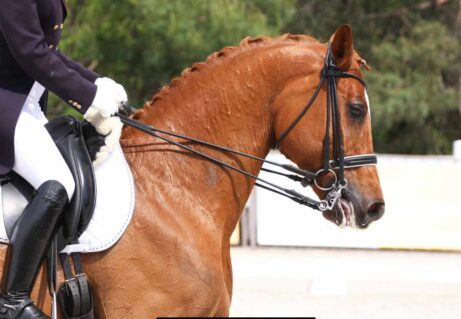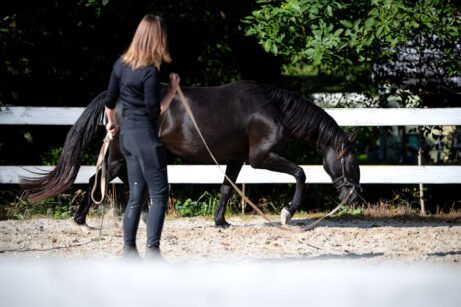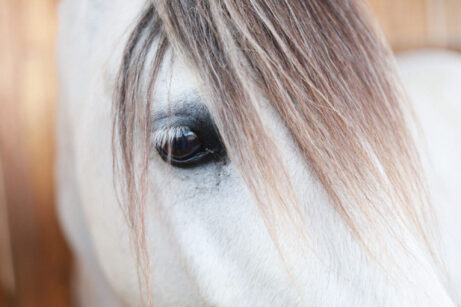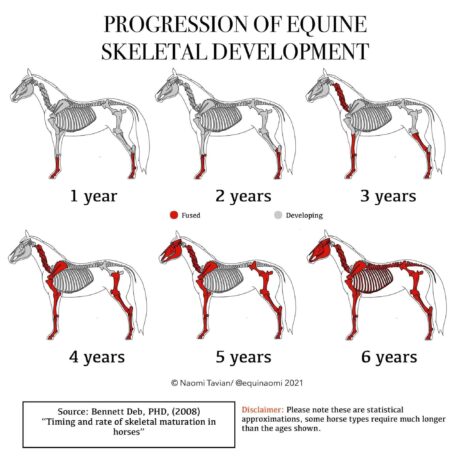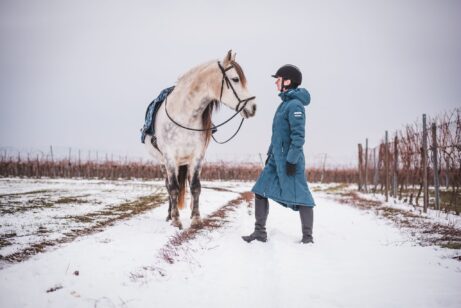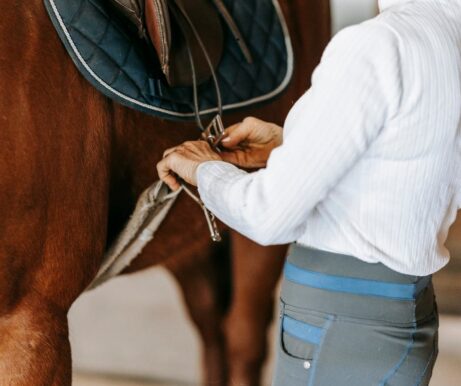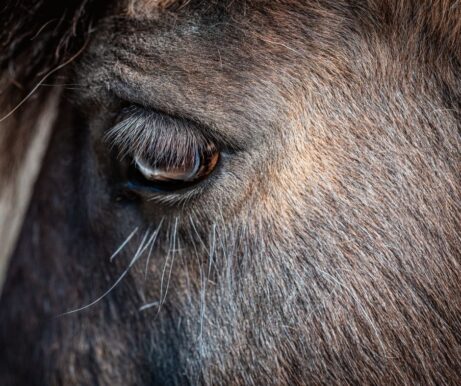Growth and Development: When Is the Right Time to Mount a Horse
Many owners of young horses are concerned with the question of when their horse is old enough to be mounted. However, the horse's age is not the only relevant criterion by which to judge such a crucial matter. The bones that form the foundation of the horse's body gradually ossify and strengthen the framework necessary to support both the horse's and the rider's weight.
Horses' bones ossify from birth to approximately 6 years of age, depending on breed and genetics. For example, in Thoroughbred and warmblood breeds, the horse is fully skeletally developed around 4-5 years, while in Arabian horses, skeletal development is slower due to a lower number of vertebrae and ribs. Their bones fully mature around 5-6 years. Draft horses, which have a more robust body frame, also mature around 5-7 years. Although bone is a relatively solid tissue, it works throughout life due to osteoblasts and osteoclasts. It is the slowest adapting tissue that changes shape according to external influences acting upon it. Rushing the mounting process can lead to irreversible degenerative changes in the bones.
But let's first clarify how a horse's bones ossify. Bones ossify from the ground up. This means that the coffin bones ossify first, allowing the foal to stand and move immediately after birth, and the spine ossifies last, which provides suspension for the trunk and serves as an attachment point for muscles and tendons.

How does the ossification of horse bones progress?
- At birth: coffin bone
- 6 months: pastern and short pastern bones
- 1 year: metacarpal and metatarsal bones
- 2 years: carpal and tarsal joints
- 3 years: radius and ulna in the front limb and tibia in the hind limb, cervical vertebrae C2-C7
- 3 ½ years: humerus and calcaneus bone
- 4 years: scapula and femur
- 5 years: lower jaw and pelvis
- 6 years: thoracic vertebrae T7-T18, lumbar vertebrae L1-L6, sacral vertebrae S1-S5, and caudal vertebrae – in mares and stallions, the spine grows faster; in geldings, the process of spine ossification slows down by about 6 months
The withers and atlas vertebra develop last
This timeline provides a detailed overview of the bone ossification process in horses, highlighting how different parts of the skeleton mature at different rates. It's important information for horse owners and trainers to understand when considering the appropriate time for training and riding young horses.
Growth phases
In terms of development, we can observe several growth phases:
-> Height growth
-> Length growth
-> Width growth
-> Depth growth
However, the most crucial period is the growth during the first year of life, when growth is quite dynamic. During this period, it's necessary to focus on the quality and quantity of nutrition provided, type of housing, horse management, and other factors. It's desirable for the foal to grow symmetrically, and the feed ration should be adjusted accordingly. If the feed ration is excessive or unbalanced, it forces the horse to accelerate the growth process, which later results in asymmetry and disturbed growth zones. Therefore, we should regularly measure the foal and monitor its growth and development.
For older horses, it's necessary to properly fit the saddle, bridle, and bit according to their needs before mounting. Let's not forget that the saddle needs to be regularly checked and adjusted according to the horse's physical changes. Even older horses change and develop muscles.
Training with Respect to the Ossification Curve
Training the horse before mounting and the mounting itself should be planned with respect to the ossification curve. The basis of training, whether for a foal or a three-year-old horse, is unlimited time, patience, logical thinking, and a sequential approach.
When working with a foal, the key is not to overload it and to be patient, always allocate enough free time for work and divide the work into short stages:
-> start by touching the foal – establishing close contact while thoroughly mapping its body
-> accustom the foal to a halter and lead rope, leading and then tying, working with pressure (yielding during handling, etc.)
-> take maximum half-hour walks in various terrains
-> introduce the horse to unusual situations
-> conversely, avoid lunging the foal – when lunging in small circles, the foal faces great imbalance, which can affect the symmetry of development during growth and also puts undue stress on the not yet strengthened joints and ligaments of the limbs.
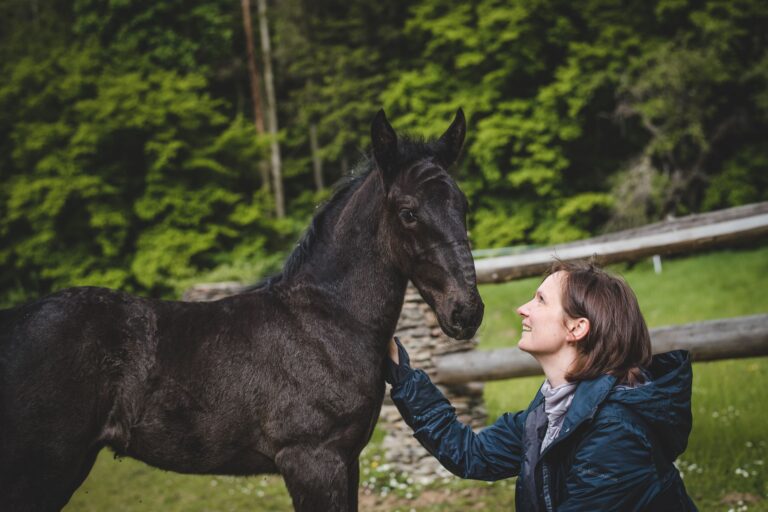
A two-year-old horse should understand basic respect for personal space, walk comfortably on a lead, and be able to remain tied during handling. At this point, it's good to pay more attention to groundwork.
-> work in hand – bending, turns, backing up, leading the horse from both right and left sides
-> exercises for weight shifting are very beneficial – they help the horse find balance
-> work at liberty – responding to voice commands, moving at walk, trot, and canter in a circle (but not for long periods, as circular movement represents an disproportionate load for a young horse)
A three-year-old horse at this stage should be able to handle hour-long hand walks, voice commands, and the basics of groundwork.
-> regular hand walks
-> focus on lunging work (without side reins!) using a cavesson, but we don't lunge for long periods or on small circles
-> introduce the horse to the saddle pad and girth
-> introduce the horse to the bit
Once the horse can handle all these skills without signs of fatigue or stress, we begin to focus on preparation for mounting. Personally, I believe that the later a horse is mounted, the better.
When working with a young horse in training, it's necessary to ensure short, not too intense training sessions – approximately up to 20 minutes. The larger the horse's frame, the shorter the interval should be.
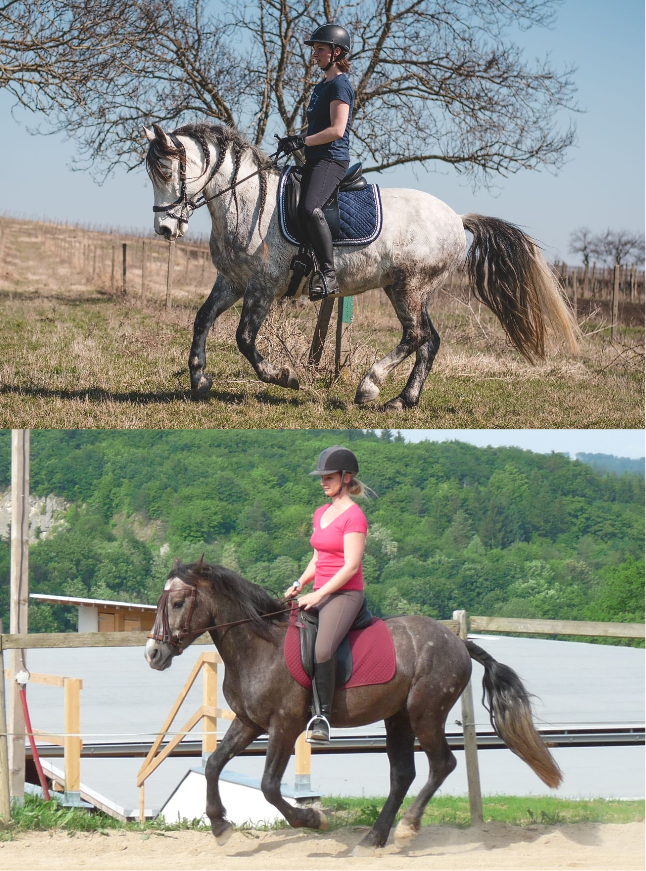
Horse Development
year 2021 (11-year-old horse) vs. 2013 (3-year-old horse).
This article for Awakened Equestrian was created by Nikola Kováříková, EEBW
@equine_study
Read more

